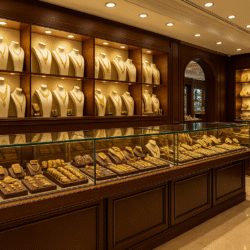Jordan shoes have been a cultural phenomenon for many years, extending beyond the realm of basketball to become an icon of style, rarity, and personal expression. But with their growing popularity and the usually outrageous prices of genuine pairs, a secondary market has been created: the market for replica Jordan shoes, or as they are more commonly known, “Reps.” These shoes, which copy the style and specifications of the original Air Jordans, have created quite a controversy about their quality, morality, and influence on sneaker culture. In this article, we delve into the complexities of Rep Jordans, such as their history, craftsmanship, the ethical controversy surrounding them, and their place in the sneaker culture.
The Rise of Rep Jordan Shoes
Fake sneakers are nothing new. Going back to the 1980s, there have been knockoff versions of high-end sneakers, although the quality tended to be bad and easily identifiable as fake. In recent years, however, the manufacturers of replicas have upped their game. Now, some high-end replica Jordans, which are sometimes referred to as “UA” (unauthorized authentic) or “1:1 Reps,” are almost impossible to tell from their retail counterparts in materials, shape, and construction.
The main cause of the replica Jordan boom is the increasing demand and scarcity of original pairs. Nike and Jordan Brand use tactics like limited drops, collaborations, and premium retail prices to create exclusivity. Consequently, resellers take advantage of the scarcity, selling for double or even triple the original price. This has made most sneaker fans unable to buy or get their preferred shoes, leading them to opt for high-quality replicas as a substitute.
The Craftsmanship and Quality of Rep Jordans
One of the most important breakthroughs in the replica sneaker business is the higher quality of material and construction. Whereas previous knockoffs were instantly recognizable because they were poorly stitched, misshapen silhouettes, and had improperly placed logos, contemporary replicas have fixed many of these issues.
Top-quality Rep Jordans nowadays employ top-grain leather, precise stitching designs, and even proper midsole cushioning to mimic the touch of retail-grade versions. Manufacturing facilities that create these shoes are known to invest a lot of time studying authentic versions, frequently buying retail examples to take apart and study the build. A few of the best rep manufacturers even provide multiple “batches,” enabling buyers to choose variants that are nearest to the real thing.
The Ethics of Buying Replica Jordans
The moral debate surrounding rep sneakers is one of the most contentious issues in sneaker culture. On one side, some argue that purchasing replicas undermines the hard work of designers and the exclusivity that makes Jordan sneakers so coveted. Others believe that the high resale prices and artificial scarcity make authentic pairs inaccessible to many consumers, making reps a reasonable alternative for those who simply love the aesthetic and design.
Additionally, the legal implications of buying and selling reps vary by country. In some regions, purchasing replicas for personal use is not illegal, while selling them as authentic is considered fraud. Nike and Jordan Brand actively combat counterfeit production, but the sheer volume of replica factories—mostly based in China—makes it challenging to eliminate them entirely.
The Impact of Reps on Sneaker Culture
Rep Jordans have sparked significant debate within the sneakerhead community. Some purists believe that wearing reps dilutes the culture and devalues the prestige of owning rare and authentic Jordans. Others argue that sneaker culture should be about appreciation rather than status, and reps allow more people to enjoy iconic designs without financial strain.
Interestingly, the presence of reps has also influenced the market for authentic sneakers. With more consumers opting for high-quality replicas, resale prices for some models have slightly declined, forcing resellers to adjust their strategies. Furthermore, brands like Nike have increased their efforts to introduce new models and colorways to maintain consumer interest in authentic pairs.
Identifying Reps vs. Authentic Jordans
For those who prioritize authenticity, knowing how to distinguish between reps and retail Jordans is essential. Some key differences to look for include:
- Box and Packaging: Authentic Jordans come with high-quality packaging, including sturdy boxes and properly printed labels. Rep boxes are sometimes flimsier or have slightly off-color fonts.
- Material and Stitching: While top-tier reps are improving, minor inconsistencies in stitching patterns, leather texture, and panel alignment may still be noticeable.
- Sole and Cushioning: Authentic Jordans often use proprietary technology such as Nike Air cushioning, whereas some reps may not fully replicate the performance aspects of the shoe.
- Smell and Glue Marks: Genuine Jordans usually have a specific factory scent, while some replicas may have an excessive glue smell due to different manufacturing processes.
The Future of Replica Sneakers
The replica sneaker industry shows no signs of slowing down, with factories continuously refining their craft to produce better and more accurate replicas. As technology advances, 3D printing and other manufacturing innovations may make it even harder to distinguish reps from authentic sneakers.
Brands like Nike and Jordan Brand will likely continue to combat counterfeits by implementing new authentication methods, such as NFC chips or blockchain technology to verify authenticity. However, as long as demand for rare sneakers remains high and supply remains limited, the market for replicas will persist.
Conclusion
Rep Jordan shoes are an unpopular yet unarguable facet of sneaker culture. They are an economic means of experience for classic models for those for whom resale madness is unacceptable. They erode the legitimacy and scarcity that makes Jordans sought after to some.
Wherever one may be in the argument, there is no doubt that replica sneakers have revolutionized the face of the sneaker world. Whether or not brands are able to come up with new ways of beating them or adapt other pricing schemes, the debate over reps will never stop. Ultimately, the passion for sneakers—either authentic or copied—remains a common thread that unites sneakerheads around the globe.


